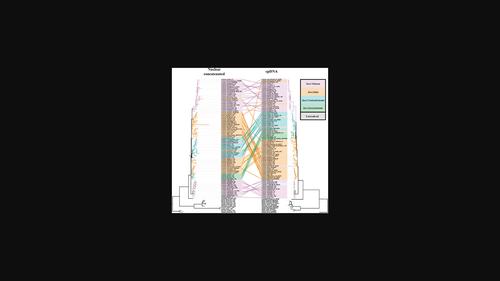New insights into infrageneric relationships of Lonicera (Caprifoliaceae) as revealed by nuclear ribosomal DNA cistron data and plastid phylogenomics
IF 3.7
引用次数: 0
Abstract
Abstract The discontinuous geographic distribution pattern of plants in the north temperate zone has been a focus of biogeographic research, especially concerning the mechanisms behind the formation of such a pattern and the spatial and temporal evolution of this intermittent distribution pattern. Hypotheses of boreotropical origin, land bridge migration, and out‐of‐Tibet have been proposed to explain the formation of the discontinuous distribution pattern. The distribution of Lonicera shows a typical Europe–Asia–North America discontinuous distribution, which makes for a good case study to investigate the above three hypotheses. In this study, we inferred the phylogeny based on plastid genomes and a nuclear data set with broad taxon sampling, covering 83 species representing two subgenera and four sections. Both nuclear and plastid phylogenetic analyses found section Isika polyphyletic, while sections Nintooa , Isoxylosteum , and Coelxylosteum were monophyletic in subgenus Chamaecerasus . Based on the nuclear and chloroplast phylogeny, we suggest transferring Lonicera maximowiczii and Lonicera tangutica into section Nintooa . Reconstruction of ancestral areas suggests that Lonicera originated in the Qinghai–Tibetan Plateau (QTP) and/or Asia, and subsequently dispersed to other regions. The aridification of the Asian interior may have facilitated the rapid radiation of Lonicera in the region. At the same time, the uplifts of the Tibetan Plateau appear to have triggered the spread and recent rapid diversification of the genus on the QTP and adjacent areas. Overall, our results deepen the understanding of the evolutionary diversification history of Lonicera .

核糖体DNA反顺子数据和质体系统基因组学揭示了金银花属内系关系的新见解
摘要/ Abstract摘要:北温带植物的间断地理分布格局一直是生物地理学研究的热点,特别是这种间歇性分布格局的形成机制及其时空演变。人们提出了北热带起源假说、陆桥迁移假说和西藏外假说来解释不连续分布格局的形成。忍冬属植物的分布呈典型的欧洲-亚洲-北美不连续分布,为上述三种假说的研究提供了很好的实例。在本研究中,我们基于质体基因组和广泛分类群采样的核数据集推断了系统发育,涵盖了两个亚属和四个断面的83种。在Chamaecerasus亚属中,核和质体系统发育分析均发现Isika剖面为多系,而Nintooa、Isoxylosteum和Coelxylosteum剖面为单系。根据核和叶绿体的系统发育,我们建议将金银花(Lonicera maximmowiczii)和唐古金银花(Lonicera tangutica)转移到nintoa组。对其祖先区域的重建表明,忍冬属植物起源于青藏高原和/或亚洲,随后分散到其他地区。亚洲内陆的干旱化可能促进了忍冬属植物在该地区的快速辐射。与此同时,青藏高原的隆升似乎引发了该属植物在青藏高原及其邻近地区的传播和近期的快速多样化。总的来说,我们的研究结果加深了对忍冬属植物进化多样化历史的认识。
本文章由计算机程序翻译,如有差异,请以英文原文为准。
求助全文
约1分钟内获得全文
求助全文

 求助内容:
求助内容: 应助结果提醒方式:
应助结果提醒方式:


